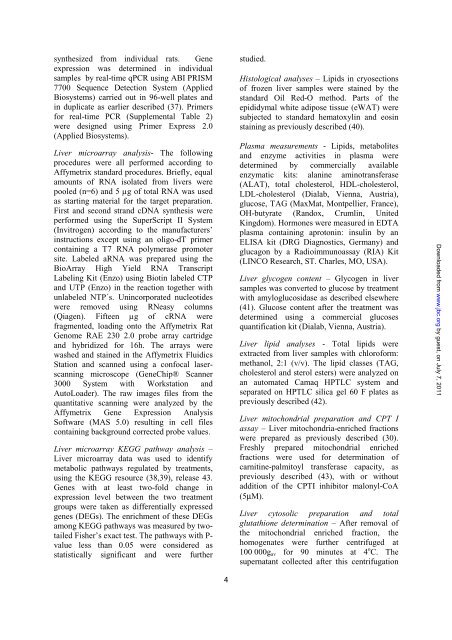The obesogenic effects of polyunsaturated fatty acids are dependent ...
The obesogenic effects of polyunsaturated fatty acids are dependent ...
The obesogenic effects of polyunsaturated fatty acids are dependent ...
You also want an ePaper? Increase the reach of your titles
YUMPU automatically turns print PDFs into web optimized ePapers that Google loves.
synthesized from individual rats. Gene<br />
expression was determined in individual<br />
samples by real-time qPCR using ABI PRISM<br />
7700 Sequence Detection System (Applied<br />
Biosystems) carried out in 96-well plates and<br />
in duplicate as earlier described (37). Primers<br />
for real-time PCR (Supplemental Table 2)<br />
were designed using Primer Express 2.0<br />
(Applied Biosystems).<br />
Liver microarray analysis- <strong>The</strong> following<br />
procedures were all performed according to<br />
Affymetrix standard procedures. Briefly, equal<br />
amounts <strong>of</strong> RNA isolated from livers were<br />
pooled (n=6) and 5 µg <strong>of</strong> total RNA was used<br />
as starting material for the target preparation.<br />
First and second strand cDNA synthesis were<br />
performed using the SuperScript II System<br />
(Invitrogen) according to the manufacturers’<br />
instructions except using an oligo-dT primer<br />
containing a T7 RNA polymerase promoter<br />
site. Labeled aRNA was prep<strong>are</strong>d using the<br />
BioArray High Yield RNA Transcript<br />
Labeling Kit (Enzo) using Biotin labeled CTP<br />
and UTP (Enzo) in the reaction together with<br />
unlabeled NTP´s. Unincorporated nucleotides<br />
were removed using RNeasy columns<br />
(Qiagen). Fifteen µg <strong>of</strong> cRNA were<br />
fragmented, loading onto the Affymetrix Rat<br />
Genome RAE 230 2.0 probe array cartridge<br />
and hybridized for 16h. <strong>The</strong> arrays were<br />
washed and stained in the Affymetrix Fluidics<br />
Station and scanned using a confocal laserscanning<br />
microscope (GeneChip® Scanner<br />
3000 System with Workstation and<br />
AutoLoader). <strong>The</strong> raw images files from the<br />
quantitative scanning were analyzed by the<br />
Affymetrix Gene Expression Analysis<br />
S<strong>of</strong>tw<strong>are</strong> (MAS 5.0) resulting in cell files<br />
containing background corrected probe values.<br />
Liver microarray KEGG pathway analysis –<br />
Liver microarray data was used to identify<br />
metabolic pathways regulated by treatments,<br />
using the KEGG resource (38,39), release 43.<br />
Genes with at least two-fold change in<br />
expression level between the two treatment<br />
groups were taken as differentially expressed<br />
genes (DEGs). <strong>The</strong> enrichment <strong>of</strong> these DEGs<br />
among KEGG pathways was measured by twotailed<br />
Fisher’s exact test. <strong>The</strong> pathways with P-<br />
value less than 0.05 were considered as<br />
statistically significant and were further<br />
studied.<br />
Histological analyses – Lipids in cryosections<br />
<strong>of</strong> frozen liver samples were stained by the<br />
standard Oil Red-O method. Parts <strong>of</strong> the<br />
epididymal white adipose tissue (eWAT) were<br />
subjected to standard hematoxylin and eosin<br />
staining as previously described (40).<br />
Plasma measurements - Lipids, metabolites<br />
and enzyme activities in plasma were<br />
determined by commercially available<br />
enzymatic kits: alanine aminotransferase<br />
(ALAT), total cholesterol, HDL-cholesterol,<br />
LDL-cholesterol (Dialab, Vienna, Austria),<br />
glucose, TAG (MaxMat, Montpellier, France),<br />
OH-butyrate (Randox, Crumlin, United<br />
Kingdom). Hormones were measured in EDTA<br />
plasma containing aprotonin: insulin by an<br />
ELISA kit (DRG Diagnostics, Germany) and<br />
glucagon by a Radioimmunoassay (RIA) Kit<br />
(LINCO Research, ST. Charles, MO, USA).<br />
Liver glycogen content – Glycogen in liver<br />
samples was converted to glucose by treatment<br />
with amyloglucosidase as described elsewhere<br />
(41). Glucose content after the treatment was<br />
determined using a commercial glucoses<br />
quantification kit (Dialab, Vienna, Austria).<br />
Liver lipid analyses - Total lipids were<br />
extracted from liver samples with chlor<strong>of</strong>orm:<br />
methanol, 2:1 (v/v). <strong>The</strong> lipid classes (TAG,<br />
cholesterol and sterol esters) were analyzed on<br />
an automated Camaq HPTLC system and<br />
separated on HPTLC silica gel 60 F plates as<br />
previously described (42).<br />
Liver mitochondrial preparation and CPT I<br />
assay – Liver mitochondria-enriched fractions<br />
were prep<strong>are</strong>d as previously described (30).<br />
Freshly prep<strong>are</strong>d mitochondrial enriched<br />
fractions were used for determination <strong>of</strong><br />
carnitine-palmitoyl transferase capacity, as<br />
previously described (43), with or without<br />
addition <strong>of</strong> the CPTI inhibitor malonyl-CoA<br />
(5µM).<br />
Liver cytosolic preparation and total<br />
glutathione determination – After removal <strong>of</strong><br />
the mitochondrial enriched fraction, the<br />
homogenates were further centrifuged at<br />
100 000g av for 90 minutes at 4 o C. <strong>The</strong><br />
supernatant collected after this centrifugation<br />
Downloaded from www.jbc.org by guest, on July 7, 2011<br />
4
















